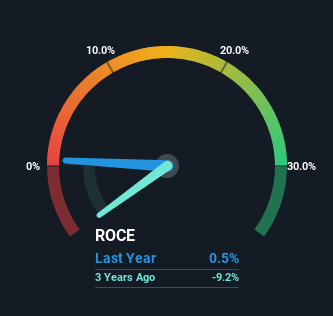LiveRamp Holdings' (NYSE:RAMP) Returns On Capital Are Heading Higher
Did you know there are some financial metrics that can provide clues of a potential multi-bagger? One common approach is to try and find a company with returns on capital employed (ROCE) that are increasing, in conjunction with a growing amount of capital employed. Put simply, these types of businesses are compounding machines, meaning they are continually reinvesting their earnings at ever-higher rates of return. So on that note, LiveRamp Holdings (NYSE:RAMP) looks quite promising in regards to its trends of return on capital.
What Is Return On Capital Employed (ROCE)?
Just to clarify if you're unsure, ROCE is a metric for evaluating how much pre-tax income (in percentage terms) a company earns on the capital invested in its business. Analysts use this formula to calculate it for LiveRamp Holdings:
Return on Capital Employed = Earnings Before Interest and Tax (EBIT) ÷ (Total Assets - Current Liabilities)
0.0052 = US$5.2m ÷ (US$1.2b - US$209m) (Based on the trailing twelve months to December 2023).
So, LiveRamp Holdings has an ROCE of 0.5%. In absolute terms, that's a low return and it also under-performs the Software industry average of 7.4%.
Check out our latest analysis for LiveRamp Holdings
In the above chart we have measured LiveRamp Holdings' prior ROCE against its prior performance, but the future is arguably more important. If you'd like to see what analysts are forecasting going forward, you should check out our free analyst report for LiveRamp Holdings .
So How Is LiveRamp Holdings' ROCE Trending?
We're delighted to see that LiveRamp Holdings is reaping rewards from its investments and has now broken into profitability. The company was generating losses five years ago, but now it's turned around, earning 0.5% which is no doubt a relief for some early shareholders. In regards to capital employed, LiveRamp Holdings is using 27% less capital than it was five years ago, which on the surface, can indicate that the business has become more efficient at generating these returns. The reduction could indicate that the company is selling some assets, and considering returns are up, they appear to be selling the right ones.
In another part of our analysis, we noticed that the company's ratio of current liabilities to total assets decreased to 17%, which broadly means the business is relying less on its suppliers or short-term creditors to fund its operations. So shareholders would be pleased that the growth in returns has mostly come from underlying business performance.
The Bottom Line
In a nutshell, we're pleased to see that LiveRamp Holdings has been able to generate higher returns from less capital. Given the stock has declined 36% in the last five years, this could be a good investment if the valuation and other metrics are also appealing. That being the case, research into the company's current valuation metrics and future prospects seems fitting.
On a separate note, we've found 2 warning signs for LiveRamp Holdings you'll probably want to know about.
While LiveRamp Holdings isn't earning the highest return, check out this free list of companies that are earning high returns on equity with solid balance sheets.
Have feedback on this article? Concerned about the content? Get in touch with us directly. Alternatively, email editorial-team (at) simplywallst.com.
This article by Simply Wall St is general in nature. We provide commentary based on historical data and analyst forecasts only using an unbiased methodology and our articles are not intended to be financial advice. It does not constitute a recommendation to buy or sell any stock, and does not take account of your objectives, or your financial situation. We aim to bring you long-term focused analysis driven by fundamental data. Note that our analysis may not factor in the latest price-sensitive company announcements or qualitative material. Simply Wall St has no position in any stocks mentioned.

